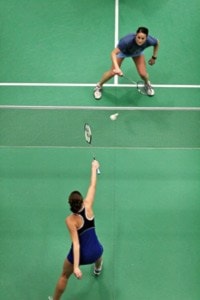Badminton matches can slip past you pretty easily. They don’t make much noise and they don’t last very long.
And the better the players, the more silent the games — or so it seems.
The 2006 Yonex Nationals, which wrap up tomorrow at the Canada Games Centre, present some of the best badminton anyone will see in Canada this year.
If you go, keep your eyes peeled.
“It’s the fastest racquet sport, and when you get to that level, you blink and you miss it,” said Jean Francois Roldan, the Whitehorse badminton enthusiast responsible for bringing the nation’s best players to town.
Games rarely break the 30-minute mark; the players hover like hummingbirds, limbs flailing out to smack the bird before you can see it.
Success at the Yonex Nationals, also known as the Canadian Senior Badminton Championships, determines the ranking of players hoping to make the Commonwealth and Olympic teams.
It’s a who’s who of the badminton set.
“We have Andrew Dabeka and (top seeded) Bobby Milroy, who are very strong in Men’s singles, and Stefan Wojcikiewicz, who’s been up there for a couple years; they’ve all won nationals at some point,” said Ron Graf, vice-president of Badminton Canada, and a pan-am level umpire.
“We have Anna Rice and Charmaine Reid, who’ve both been to the Olympics.”
Never heard of ‘em?
It’s true that badminton doesn’t get much attention. There’s no Tiger Woods type bringing in the crowds. But Graf thinks anyone who comes out will be impressed. “People are astounded at what badminton has evolved into.”
The elite of Canada’s badminton scene form the bulk of the 29 players in the tournament, but they aren’t the only ones providing some serious action here.
“Actually, anyone can register and play in the national championships; it’s just a matter of paying the entry fee,” said Graf.
“We don’t get that many (walk-on players) here because there’s not a huge badminton community in the Yukon.
“If we were in Vancouver, we might get another 20 or 30 players. You’ll often get juniors coming up; any age can play.”
The shortage of competitors doesn’t diminish the achievement of the winners, said Graf.
“I think we’ve got a good tournament, and whoever wins will win because they are the best, nobody’s going to win here because it’s a small draw. That won’t happen.”
Organizer Roldan is the only hometown walk-on entrant in the tournament, and he doesn’t have any illusions.
“I used to play at the elite level in Quebec, and I really wanted to play here,” said Roldan, who lost his opening match on Wednesday to Ontario’s Kyle Hunter.
“It’s been a good experience, but it showed my lack of training,”
“I was OK the first few rallies of the game, but then I got tired pretty fast, and mistakes started happening. I’d like to play it again with a bit more training.”
It’s a single elimination style tournament, and Roldan now moves into the consolation rounds.
“I would have liked to play mixed doubles, but I’m the only player from the Yukon,” he added.
The territory might not be a badminton stronghold, but there is a team Yukon standing in the shadows of the tournament.
The Arctic Winter Games badminton squad hopefuls are volunteering as line judges.
They will also take advantage of the four professional Yonex courts for their Sunday tryouts.
Canada Games Centre regulars may not recognize the Flexi-hall where the tournament is being held.
The lights are dimmed, and blinders have been set up to minimize glare and distractions.
It’s a bit of an experiment, finding out what works best. Next year’s Canada Games will hold the badminton event in the same venue. Only on a much bigger scale, with over 100 athletes on eight courts.
“We have some issues to look at with the Canada Games Centre, figuring out lighting, and breezes and things like that,” said Bruce Thomson, the badminton sport chair for the Canada Games and one of the organizers of the Yonex Nationals.
“Having the best players here is a good way to do that.”
These top athletes know what good playing conditions are, and the local organizers are paying attention to the feedback they are getting.
“From a size point of view, it’s wonderful, but we have work to do as far as lighting and air movement, a shuttle is only five grams, so air movement can really affect it,” said Graf, who also serves as the Canada Games badminton technical representative.
“Hopefully, by next year we’ll have all the kinks worked out.”
The semi-finals are scheduled for today starting at 4 p.m. and the finals begin Saturday at noon.
